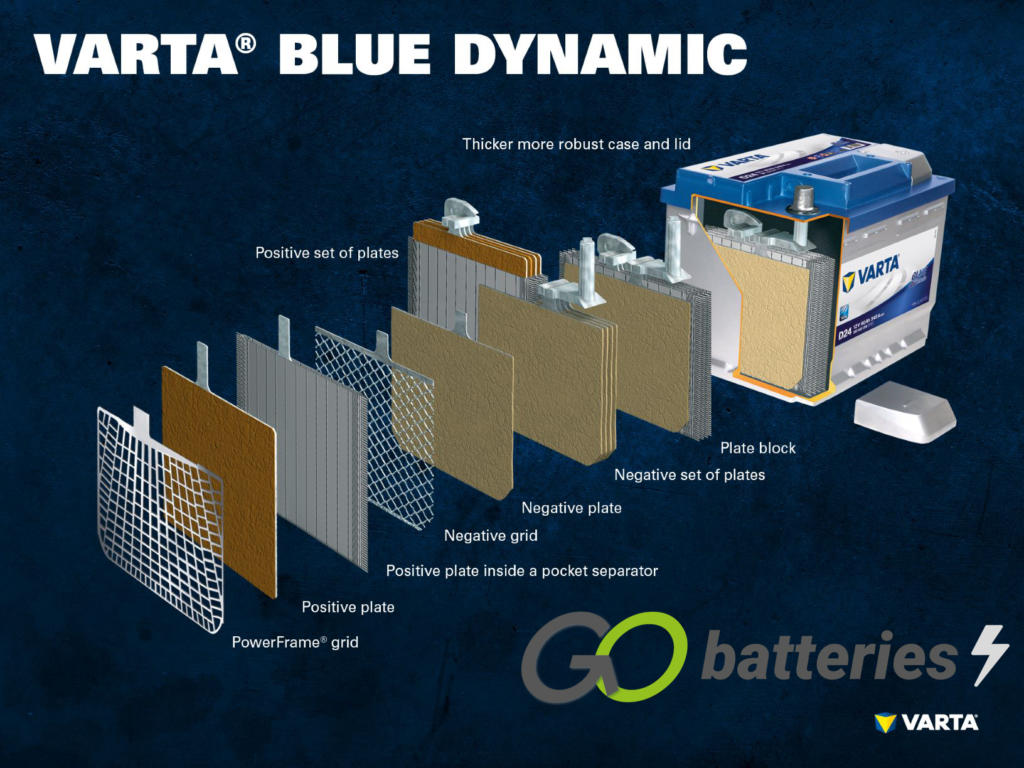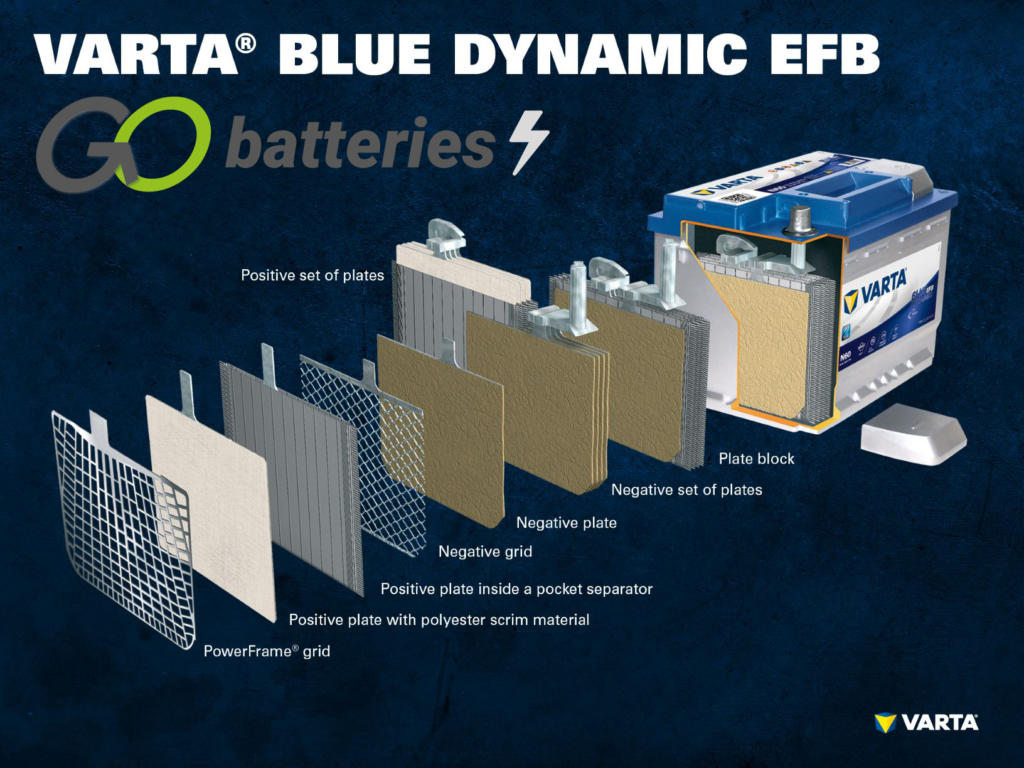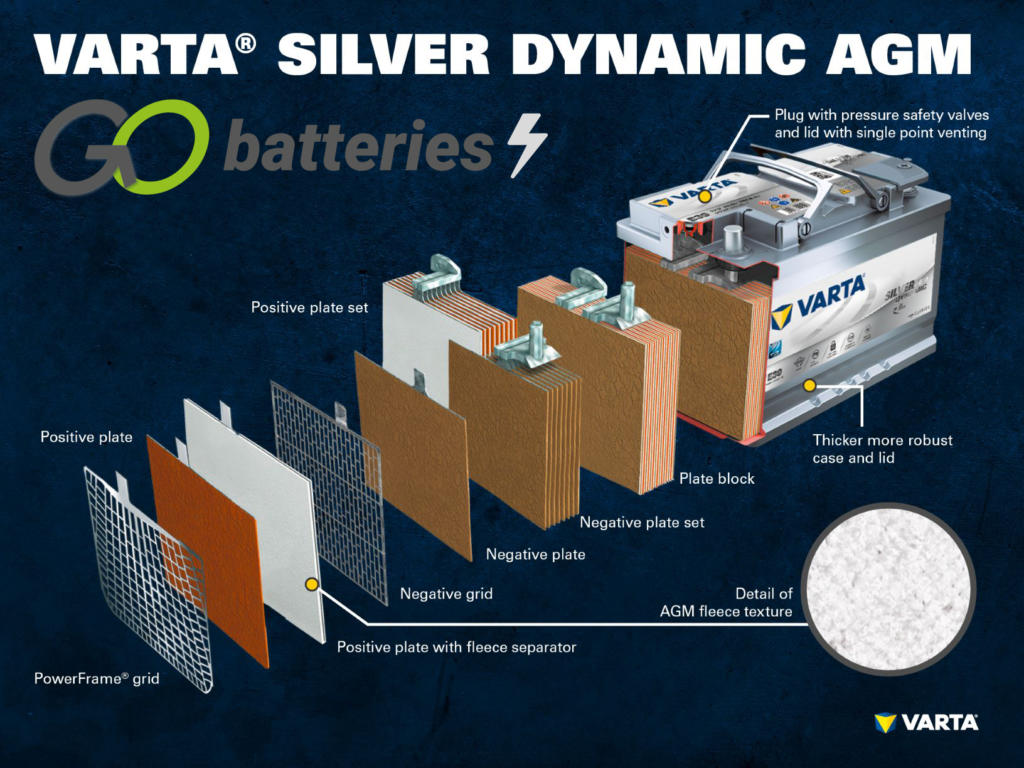
What is a Car Battery?
A Car battery is designed primarily for engine starting. Unlike other types of battery (such as Marine batteries or Leisure batteries) which are designed to perform best under slow drain situations, a car battery must be able to produce a high burst of energy to engage the starter motor and turns the fly wheel which will allow the car engine to start.
As the car battery is the heart of your vehicle’s electronics system, we recommend fitting the highest quality car battery that your budget will allow, thus getting the ultimate performance from your car over the longest period possible.
Car Battery Technologies
Wet Batteries – A traditional car battery is known as a wet (or flooded) battery. In its basic form, this is a strong plastic (usually ABS) container which contains lead plates submerged in a dilute liquid electrolyte solution (acid). These must be kept upright to avoid spillage. Batteries have been produced in this way for many, many years.

A conventional starter battery consists of 6 cells connected in series, each with a nominal voltage of 2 V, which results in a voltage of exactly 12.72 V when the battery is fully charged. The capacity and the cold start capability of the battery results from the number of plates per cell.
Rule of thumb: The more plates which a cell contains, and therefore form a larger surface, the larger the cold start power (CCA) which the battery can deliver. However, if the space in the cell is used for fewer, but thicker plates, the cycle stability is increased. This means that the battery is designed for a higher charge throughput (continual charging and discharging process).
The cells are contained in a casing which is made from acid-resistant plastic (polypropylene). In a conventional SLI battery, this is closed with a cover with a labyrinth system which prevents the battery fluid from escaping and separates the liquid from gas.
Early batteries had screw plugs which enabled them to be topped up with distilled water. Modern batteries are completely maintenance-free. Water does not need to be, and must not be topped up. Although AGM batteries still have “one-way plugs”, these must not be opened under any circumstances.
EFB Batteries – Enhanced Flooded Batteries (EFB) are best described as a hybrid between wet and AGM batteries and are the first generation of Start Stop batteries. They are designed to provide many of the benefits of an AGM battery such as increased reliability and deep cycle capabilities without the high cost. EFB batteries were fitted to early Start Stop vehicles and are currently fitted to many entry level Start Stop vehicles as standard.

EFB batteries are a further development of conventional lead-acid batteries. The Polyvlies material on the surface of the positive plate guarantees that the EFB has a longer service life. EFB batteries have a low internal resistance and are characterised by twice the number of charging cycles* in comparison with conventional starter batteries, as well as a high load capacity.
EFB batteries are suitable for the power supply of cars:
- with simple automatic start-stop systems
- without start-stop, but with demanding driving requirements (e.g. in urban traffic),
- without start-stop, but with extensive equipment.
If the vehicle is originally supplied with an EFB battery, an EFB battery can also be used as a replacement. If the car owner requires even greater performance or have a very demanding driving profile with a lot of urban traffic, a powerful AGM battery can be selected.
AGM Batteries – (“AGM” stands for “Absorbent Glass Mat”) batteries were developed in the 1980’s and feature a fibreglass matting which surrounds the lead plates with the electrolyte absorbed within it. The major benefits are that the battery becomes spill proof (and so can be theoretically mounted in any position), has far better vibration resistance and is better able to deep cycle (survive multiple deep discharging and recharging). They are also (for various technical reasons) more reliable than their wet counterparts, the downside is that AGM batteries are more expensive to produce and to purchase. AGM batteries are factory fitted to the majority of premium Start Stop vehicles.
AGM Batteries, for upper mid-range cars, SUVs and premium cars
Maintenance-free and leak-proof AGM batteries are powerful batteries for automatic Start-Stop systems and have very good cold start characteristics. Thanks to the cycle stability of an AGM battery, a warm engine can be switched off and started again several times at short intervals, without the risk of difficulties when restarting. They also provide sufficient reserves to continue to supply electrical consumers during the frequent stops and still guarantee reliable starting.
An AGM battery is the ideal energy storage unit
- for vehicles with automatic Start-Stop systems and recovery of braking energy (recuperation),
- For cars with premium equipment and sophisticated accessories.

Only replace an AGM Battery with an AGM Battery
Cars with an extended automatic start-stop system are equipped with an AGM battery. Only an AGM battery may be used as a replacement.
What is the reason for the restricted choice of battery?
Batteries with modern technologies such as EFB and AGM are monitored by a battery sensor and are closely linked with the battery management system (BMS). If a wrong battery is used, this can cause deficiencies in the automatic start-stop system, failures of comfort functions and reduced service life of the battery.
When is a change from EFB to AGM recommended?
An upgrade to an AGM battery is always advisable if a large number of electrical consumers cause an increased power demand or if maximum availability for use is required. One advantage of AGM batteries is the fuel saving which is achieved with the effective operation of the automatic Start-Stop system – and therefore saving money. All consumers in the onboard network benefit from a good power supply, even during stop phases and also operate reliably under unfavourable weather conditions.

















